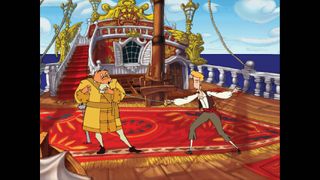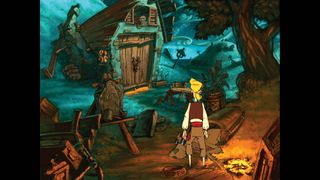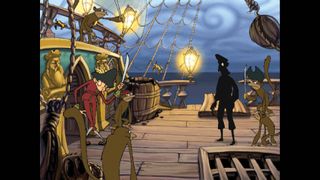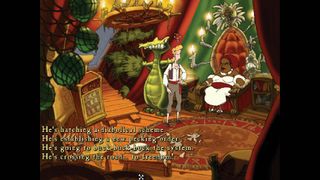Rediscovering the childhood delight of The Curse of Monkey Island
Keeping the love for a childhood favourite alive.

The first PC game I ever played was Monkey Island 2: LeChuck’s Revenge, which was included in a magazine. Because I was a kid, I lost it or scratched it as well the set of floppy disks I ended up playing the first monkey Island on, forcing me to eventually buy a bundle of both games. That bundle, called monkey Island Bounty pack came with a demo of the curse of monkey Island. The year was 1997, and I had just found the game that would likely accompany me forever.
Childhoods are filled with weird compulsions. You eat your favourite snack until the mere sight is enough to give you hives, you read the same book over and over again and you fervently declare that you will never stop loving whatever you love at the time. For many things you’ve loved as a child, games included, the fervour gradually cools.
We say goodbye to a lot of games we love, either due to technical constraints or simply because there are so many games to play. Sometimes we stop playing a game because we’re worried the present reality won’t hold up to the romantic memories we have of it. To me, The Curse of Monkey Island never fell into either box—I’ve played it at least annually for 22 years.
In the era of digital games that doesn’t sound like much of a feat, but I’ve kept this game in its original box with me, moving to different flats and across countries. It felt very normal to do so; you pack your favourite book, I pack Monkey Island (and some underwear).

Looking at the system requirements really puts the continuous advancement of technology into perspective, right down to the paradoxical yet entirely understandable fear that your system has become too powerful to run your favourite game. 16MB RAM! Windows 95! DirectX 5!
Those were different times. Miraculously, Monkey Island always ran fine no matter what system I used, and I didn’t need to use ScummVM to run it until a few years ago, just prior to its GOG and Steam releases. I didn’t play the game like clockwork, like I had to uphold a tradition, but because inevitably, one day I’d think “this feels like a good time to play Monkey Island”.
Island getaway
Perhaps playing isn’t the right word anymore. After this long it’s more like visiting a bunch of friends, like Willy Blondbeard in his chicken restaurant or Dinghy the dog. Monkey Island has always been a series of characters that don’t exist to fulfil any grand narrative function. Rather, they’re there to be manipulated by me, so I can get whatever item or piece of information I’m after at that time.
The biggest gaming news, reviews and hardware deals
Keep up to date with the most important stories and the best deals, as picked by the PC Gamer team.
The outline of MI3 is simple—in order to lift a curse from his beloved Elaine Marley, Guybrush Threepwood, self-proclaimed mighty pirate, has to give her a ring symbolising true love.

He roughly knows where it is, but he needs a crew and a ship, and he hasn’t really worked out the whole attaining the ring part, either.
Characters that are essentially useless props still have detailed, fun stories to tell, even when they’re just built around one character attribute. Every pirate you meet, whether it’s on Plunder Island, a retirement community for pirates, or out on Blood Island, the pirate family resort, each has a great yarn of a past adventure to offer, and each of them has grown on me as a result.
Since I’m unable to play the game the way it was intended to be played by now, knowing the solution to every puzzle by heart, this attachment to each character is likely a large part of what makes Monkey Island so evergreen for me. It’s one of my great regrets that I don’t remember how I’ve solved these puzzles in the pre-internet age, if I bought a guide and what happened to it. The solutions to puzzles in any Monkey Island are so arbitrary that I can’t imagine having solved most of them as a pre-teen without help. It’s also worth noting that The Curse of Monkey Island isn’t really an evergreen by conventional standards.
Monkey love

In 1998, PC Gamer put it in 33rd place on its list of the 50 best computer games ever released, but if you look at any best-of list for adventure games now, The Secret of Monkey Island or Monkey Island 2 are much more likely to appear, having left a bigger impact with players overall. It took ages to appear on digital storefronts, while its precursors were remade a decade ago. These versions allow you to play with updated graphics and voice over, or with the classic 1990s pixels.
The Curse of Monkey Island didn’t need such a do-over—while I’d love to have it in HD, its 2D art style still looks fresh. It’s a testament to the quality of the art that there were so many things to look at and interact with that items necessary to solve puzzles don’t stand out. MI3 was the first game in the series to feature voices, immediately setting an industry standard for great voice acting in games. Many gaming franchises have a sequel that outstrips the original, but for many fans of Monkey Island, the first game will likely always be the best, making my love for this game, which doesn’t necessarily extend to the rest of the series, a bit of an outlier.
I get it—both predecessors offer more of the swashbuckling adventure you expect of the pirate theme, here you mostly deal with pirate pensioners. Of course I love MI3 for nostalgic reasons, too—from how it was the first game I bought with my own pocket money to how I was convinced that it represented a graphical pinnacle for PC gaming because the game looked exactly the way it did on the box.
LucasArts completely overhauled its SCUMM engine for one last hurrah to produce the look of MI3.
Inspirational quotes

More interesting than the impossible question of why you fall in love with a game is how that love turns into something enduring. In my case it was Monkey Island’s unmatched quotability. I don’t mean “you fight like a cow” or anything involving three-headed monkeys.
Instead, I have a huge list of completely unsusceptible quotes everyone around me knows must hark back to something, but no one ever bothers to ask me about. My favourites are exclamations of surprise, “Aah! Death again!” comes from Madame Xima at the Goodsoup Hotel on Blood Island—it has been my go-to to express surprise. When someone asks me to do something, I may ask them to beat me in the caber toss first. This is one of the tasks Guybrush has to cheat his way through to gain Haggis McMutton as a member of his crew. “I think I’m getting better at this,” isn’t much of a quote, but it’s me channelling my inner Effette Lafoot, the temp lowering Guybrush to the smuggler’s cave on Skull Island.
None of these quotes have meaning beyond what I’ve ascribed to them. You can’t put them on t-shirts or posters, they don’t immediately bring an image to mind, but they’re the best way to always have something you love with you, reinforcing the memory of good times. While it’s fun to explore my attachment to a game that isn’t an obvious first choice for many people, in the end you form attachment over the weirdest things and sometimes love a game, just because.
Most Popular

